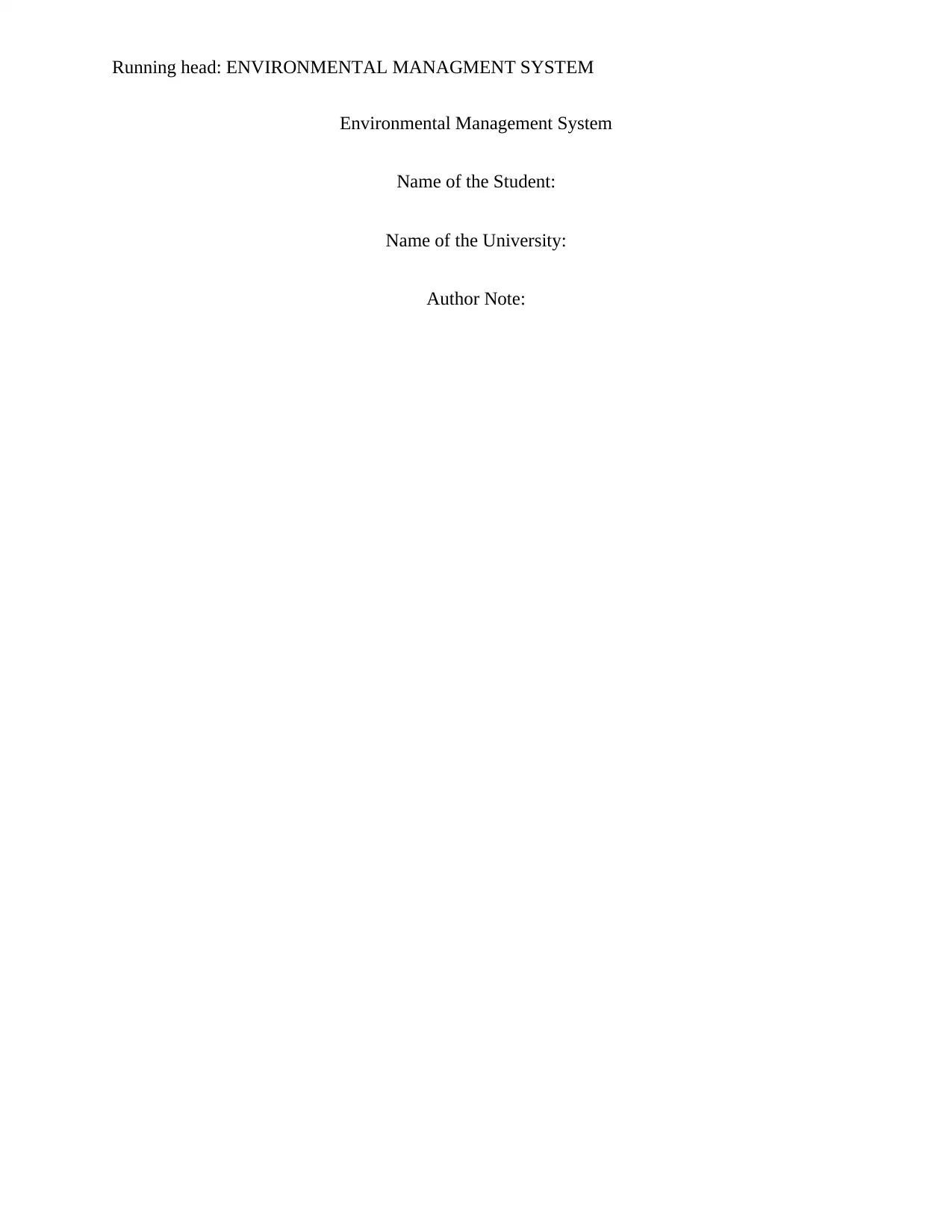Environmental Management System: An In-Depth Essay
VerifiedAdded on 2020/03/04
|5
|888
|45
Essay
AI Summary
This essay provides an overview of Environmental Management Systems (EMS), emphasizing their role in managing environmental impact. It highlights the EMS model based on the Plan-Do-Check-Act (PDCA) cycle, and the importance of adhering to environmental laws like Australia's EPBC Act 1999. The essay discusses the benefits of EMS, such as reduced greenhouse gas emissions, cost savings through energy efficiency, and revenue generation from waste recycling. It also addresses the disadvantages, including the high investment costs in technology and manpower, which often limit adoption to larger multinational companies. The essay references ISO 14001 as a widely used standard for measuring EMS, and concludes that while EMS can reduce energy emissions and waste management expenditures, significant financial investments are required for its implementation.

Running head: ENVIRONMENTAL MANAGMENT SYSTEM
Environmental Management System
Name of the Student:
Name of the University:
Author Note:
Environmental Management System
Name of the Student:
Name of the University:
Author Note:
Paraphrase This Document
Need a fresh take? Get an instant paraphrase of this document with our AI Paraphraser

1
ENVIRONMENTAL MANAGMENT SYSTEM
Environment management system or EMS is the method of managing environment using
technology to counteract the impact of environmental degeneration. I can point out that
organisations today integrate external environmental factors like legal and technological
framework to achieve environmental management. It has evolved into an area of study which is
drawing interest from experts and enjoys support from international organisations like the United
Nations.
Environmental management system according to me aims to establish compliance with
environmental laws and achievement efficient waste management. All the countries in the
world mandate the business organisations to comply with environmental laws like EPBC Act
1999 of Australia, failing which attracts legal and penal actions (Legislation. 2017). The second
aim reduction of waste is an expensive procedure which requires the organisations to invest in
operating in sustainable modes like installation of modern energy efficient plants and employing
skilled labour.
The environment management system model or the EMS Model is a model following
Plan-Do-Check-Act (PDCA) Cycle. The model emphasises on making environmental policies in
the organisations incorporate the environmental laws, outlining the strategies to ensure
environmental protection and laying down plans to implement the environmental strategies. The
organisations follow several standards to measure EMS of which International Organisation for
Standardisation (ISO) 14001 is the most widely used (Olaru et al., 2014).
Environmental management system has several advantages to the organisations and
society as a whole. I feel that EMS helps the organisations reduce their greenhouse gas
emission and carbon footprints (CFs) by using modern technology. This benefits the society
ENVIRONMENTAL MANAGMENT SYSTEM
Environment management system or EMS is the method of managing environment using
technology to counteract the impact of environmental degeneration. I can point out that
organisations today integrate external environmental factors like legal and technological
framework to achieve environmental management. It has evolved into an area of study which is
drawing interest from experts and enjoys support from international organisations like the United
Nations.
Environmental management system according to me aims to establish compliance with
environmental laws and achievement efficient waste management. All the countries in the
world mandate the business organisations to comply with environmental laws like EPBC Act
1999 of Australia, failing which attracts legal and penal actions (Legislation. 2017). The second
aim reduction of waste is an expensive procedure which requires the organisations to invest in
operating in sustainable modes like installation of modern energy efficient plants and employing
skilled labour.
The environment management system model or the EMS Model is a model following
Plan-Do-Check-Act (PDCA) Cycle. The model emphasises on making environmental policies in
the organisations incorporate the environmental laws, outlining the strategies to ensure
environmental protection and laying down plans to implement the environmental strategies. The
organisations follow several standards to measure EMS of which International Organisation for
Standardisation (ISO) 14001 is the most widely used (Olaru et al., 2014).
Environmental management system has several advantages to the organisations and
society as a whole. I feel that EMS helps the organisations reduce their greenhouse gas
emission and carbon footprints (CFs) by using modern technology. This benefits the society

2
ENVIRONMENTAL MANAGMENT SYSTEM
and earns the organisations goodwill which enhances their corporate in the market. The second
advantage of EMS to the organisations is reduction in cost of productions and operations. The
organisations can install modern machinery which uses less energy and emits minimum heat and
wastes, thus saving energy costs and waste management cost to the company. Secondly investing
in monitoring and controlling wastes in scientific methods in my opinion help the companies to
recycle their wastes and use them to generate energy. This way they can cut down their energy
expenditure in buying energy from third party energy firms and use the energy produced from
waste to operate. These companies can even sell surplus energy to other companies and generate
revenue (Dunwoody & Peters, 2016). Thus, EMS helps the companies to reduce their energy
expenditure, cut down waste management expenditure, become energy efficient and earn
revenue to selling energy to other firms.
EMS helps companies to deal with cost pressures, become energy efficient, augment their
profits, strengthen their goodwill but has certain disadvantages. The greatest disadvantage of
EMS is that it mandates the companies to invest in modern technology and manpower which
often prove to be very expensive. Thus it is clear that EMS can be afforded mostly by
multinational companies which are financially strong. The second weakness of EMS is that its
results can only be realised in the long run. I feel these demerits often restrict the business
organisations from adopting EMS (Albertini, 2013).
It can concluded in a nutshell that EMS helps the organisations to reduce their energy
emissions and waste management expenditures. However, it requires huge investment in
technology, plants and manpower. I feel this heavy expenditures has largely restricted adoption
of EMS to large multinational companies who have the financial, technological and employee
power to adopt it.
ENVIRONMENTAL MANAGMENT SYSTEM
and earns the organisations goodwill which enhances their corporate in the market. The second
advantage of EMS to the organisations is reduction in cost of productions and operations. The
organisations can install modern machinery which uses less energy and emits minimum heat and
wastes, thus saving energy costs and waste management cost to the company. Secondly investing
in monitoring and controlling wastes in scientific methods in my opinion help the companies to
recycle their wastes and use them to generate energy. This way they can cut down their energy
expenditure in buying energy from third party energy firms and use the energy produced from
waste to operate. These companies can even sell surplus energy to other companies and generate
revenue (Dunwoody & Peters, 2016). Thus, EMS helps the companies to reduce their energy
expenditure, cut down waste management expenditure, become energy efficient and earn
revenue to selling energy to other firms.
EMS helps companies to deal with cost pressures, become energy efficient, augment their
profits, strengthen their goodwill but has certain disadvantages. The greatest disadvantage of
EMS is that it mandates the companies to invest in modern technology and manpower which
often prove to be very expensive. Thus it is clear that EMS can be afforded mostly by
multinational companies which are financially strong. The second weakness of EMS is that its
results can only be realised in the long run. I feel these demerits often restrict the business
organisations from adopting EMS (Albertini, 2013).
It can concluded in a nutshell that EMS helps the organisations to reduce their energy
emissions and waste management expenditures. However, it requires huge investment in
technology, plants and manpower. I feel this heavy expenditures has largely restricted adoption
of EMS to large multinational companies who have the financial, technological and employee
power to adopt it.
⊘ This is a preview!⊘
Do you want full access?
Subscribe today to unlock all pages.

Trusted by 1+ million students worldwide

3
ENVIRONMENTAL MANAGMENT SYSTEM
References:
Albertini, E. (2013). Does environmental management improve financial performance? A meta-
analytical review. Organization & Environment, 26(4), 431-457.
Dunwoody, S., & Peters, H. P. (2016). Mass media coverage of technological and environmental
risks: A survey of research in the United States and Germany. Public understanding of
science.
Legislation. (2017). environment.gov.au. Retrieved 17 August 2017, from
http://www.environment.gov.au/about-us/legislation
Olaru, M., Maier, D., Nicoară, D., & Maier, A. (2014). Establishing the basis for development of
an organization by adopting the integrated management systems: comparative study of
various models and concepts of integration. Procedia-Social and Behavioral
Sciences, 109, 693-697.
Rinaldi, S., Barbanera, M., & Lascaro, E. (2014). Assessment of carbon footprint and energy
performance of the extra virgin olive oil chain in Umbria, Italy. Science of The Total
Environment, 482, 71-79.
Valta, K., Aggeli, E., Papadaskalopoulou, C., Panaretou, V., Sotiropoulos, A., Malamis, D., ... &
Haralambous, K. J. (2015). Adding value to olive oil production through waste and
wastewater treatment and valorisation: the case of Greece. Waste and Biomass
Valorization, 6(5), 913-925.
ENVIRONMENTAL MANAGMENT SYSTEM
References:
Albertini, E. (2013). Does environmental management improve financial performance? A meta-
analytical review. Organization & Environment, 26(4), 431-457.
Dunwoody, S., & Peters, H. P. (2016). Mass media coverage of technological and environmental
risks: A survey of research in the United States and Germany. Public understanding of
science.
Legislation. (2017). environment.gov.au. Retrieved 17 August 2017, from
http://www.environment.gov.au/about-us/legislation
Olaru, M., Maier, D., Nicoară, D., & Maier, A. (2014). Establishing the basis for development of
an organization by adopting the integrated management systems: comparative study of
various models and concepts of integration. Procedia-Social and Behavioral
Sciences, 109, 693-697.
Rinaldi, S., Barbanera, M., & Lascaro, E. (2014). Assessment of carbon footprint and energy
performance of the extra virgin olive oil chain in Umbria, Italy. Science of The Total
Environment, 482, 71-79.
Valta, K., Aggeli, E., Papadaskalopoulou, C., Panaretou, V., Sotiropoulos, A., Malamis, D., ... &
Haralambous, K. J. (2015). Adding value to olive oil production through waste and
wastewater treatment and valorisation: the case of Greece. Waste and Biomass
Valorization, 6(5), 913-925.
Paraphrase This Document
Need a fresh take? Get an instant paraphrase of this document with our AI Paraphraser

4
ENVIRONMENTAL MANAGMENT SYSTEM
ENVIRONMENTAL MANAGMENT SYSTEM
1 out of 5
Related Documents
Your All-in-One AI-Powered Toolkit for Academic Success.
+13062052269
info@desklib.com
Available 24*7 on WhatsApp / Email
![[object Object]](/_next/static/media/star-bottom.7253800d.svg)
Unlock your academic potential
Copyright © 2020–2025 A2Z Services. All Rights Reserved. Developed and managed by ZUCOL.




